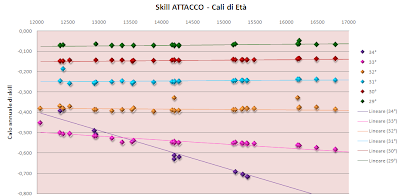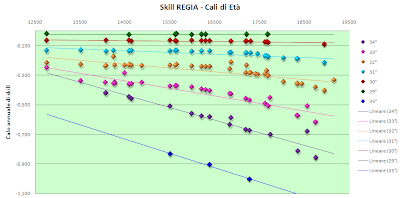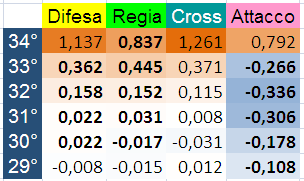*** ARTICLE
are being drafted in the third draft ... work lungoooo ***
We come to the second part of this laborious research on skill drops, this time analyzing the losses caused by old age of the player.
The questions I pose are
1) the losses are the same for every type of skill?
2) the declines in some way dependent on the level of skill?
3) how you have changed the drop after August 7?
premise that the same flameron confirmed that the drop in new skills are introduced early in the season 43 (7 August) and not with the introduction of the new salary (start of season 44).
Analogous to the first part I proceeded to
a) collect a sample of players monoskill seen for sale on the market: 50 defenders, 40 midfielders, 30 strikers, 15 wings for a total of 135 players
b) recognize the salary history Alltid up,
c) given the X salary at the date of his past birthdays, estimate the level of skill to that birthday
d) analyze the differences between the levels of skill birthday after birthday to see the declines experienced by the player (of course if it was clear that the player had received a certain amount of training, the figure was discarded here)
The data then have this form, here is that Daniel Davis, 36 year old Canadian striker:
The questions I pose are
1) the losses are the same for every type of skill?
2) the declines in some way dependent on the level of skill?
3) how you have changed the drop after August 7?
premise that the same flameron confirmed that the drop in new skills are introduced early in the season 43 (7 August) and not with the introduction of the new salary (start of season 44).
Analogous to the first part I proceeded to
a) collect a sample of players monoskill seen for sale on the market: 50 defenders, 40 midfielders, 30 strikers, 15 wings for a total of 135 players
b) recognize the salary history Alltid up,
c) given the X salary at the date of his past birthdays, estimate the level of skill to that birthday
d) analyze the differences between the levels of skill birthday after birthday to see the declines experienced by the player (of course if it was clear that the player had received a certain amount of training, the figure was discarded here)
The data then have this form, here is that Daniel Davis, 36 year old Canadian striker:
 You can see in the upper part
You can see in the upper part - his ID (61527495),
- his salary history (1470 to 36 years, 2310 to 35 years, 630 to 34 years, etc.),
- i livelli di skill stimati corrispondenti a quegli stipendi (12.995 a 36 anni, 13.942 a 35 anni, 14.637 a 34 anni ecc),
- le date dei compleanni (per vedere quanti cali il giocatore ha subito col nuovo sistema di cali introdotto il 7 agosto).
- l'entità dei cali vista al compimento di un certo compleanno (a 36 anni il giocatore manifesta un calo di 0.947 di skill, tale calo si è realizzato tra il compimento del 35° e quello del 36° compleanno, quindi maturato nel corso del 35° anno di età, idem per gli altri cali) e infine i
- l numero di cali subiti nel nuovo sistema di cali (da un minimo di 0 se i cali sono stati tutti nel old system drops to a maximum of 16 if he had a full season of new drops)
course, having obtained the first part of this work falls on the skill, the formulas of the decline in skill, high skill are able to separate the effect of the "decline of high-skill" and that the "decline of age" simply by subtracting from the total observed decline in the estimated decline from high-skill (with the old formula in the case of old drops and vice versa). The drop
that have undergone this process of "cleaning" are shown in the tables below in bold with light brown background.
This sample seen, with all the data, now cleaned up by the "drop from high-skill"
DEFENDERS








MIDFIELD






ALI



and finally ATTACKER





see how the players have always been arranged in descending order of strength (by reference to the value of skill at the age of 33 th year), just to see, trying to answer the question # 2 if the losses were in some way dependent dal livello della skill del giocatore.
I VECCHI CALI DA ETA'
Fatto quanto sopra, ho proceduto a isolare le parti in basso delle tabelle (quelle relative ai soli cali), eliminando i valori in arancione che contenevano anche parti di nuovi cali, mi restano quindi tutti i dati "puri" di cali col vecchio sistema di skill.
Ecco ad esempio i dati che emergono per la skill ATTACCO dopo avere "rovesciato a specchio" i dati in modo che i giocatori con skill alta siano a destra e quelli con skill bassa a sinistra, così più ci si sposta a destra più salga la skill.
Fatto quanto sopra, ho proceduto a isolare le parti in basso delle tabelle (quelle relative ai soli cali), eliminando i valori in arancione che contenevano anche parti di nuovi cali, mi restano quindi tutti i dati "puri" di cali col vecchio sistema di skill.
Ecco ad esempio i dati che emergono per la skill ATTACCO dopo avere "rovesciato a specchio" i dati in modo che i giocatori con skill alta siano a destra e quelli con skill bassa a sinistra, così più ci si sposta a destra più salga la skill.


Già ad occhio emergono alcune regolarità: basti osservare i dati al compimento del 31° compleanno che evidenziano il calo di skill nel corso del 30° anno di età: -0.150 -0.150 -0.147 -0.146 -0.147 -0.150 -0.148 -0.148 -0.147 -0.145 -0.146 -0.147 -0.148 ecc... è evidente come vi sia una forte regolarità dei valori, apparentemente in modo indipendente dal livello della skill.
Gli stessi dati li possiamo evidenziare in un grafico, disposti in modo da rappresentare l'effettivo livello di skill (che trovate in alto moltiplicato per mille, quindi "14000" sarà il livello 14 ecc...)
Ecco i Cali di età rilevati durante il 30° anno:

Tutti i valori sono piuttosto vicini, con una deviazione standard di soli 0.004 attorno al valore medio di -0.145
Andiamo avanti e vediamo i cali durante il 31° anno di età, che si manifestano a livello di stipendio al compimento del 32° anno (e quindi troveremo sopra in tabella nella differenza tra skill al 32° compleanno e skill al 31° compleanno)

anche qui, a parte un giocatore che manifesta un calo inferiore a causa probabilmente di qualche piccola dose di allenamento, rilevo una grande regolarità attorno a una media di -0.247 with a very low standard deviation, equal to 0.010. I quote here a linear trendline that you see the same color with colored indicators, to give an idea of \u200b\u200bthe data. The line is virtually horizontal, which would seem to indicate a level of independence between Cali and skill of the player.
even here we find the usual regularity, the data vary in the range -0.37 / -0.40 , with an average value of -0387 and a standard deviation of only 0,007 of skill. The trend line here seems substantially horizontal.
In 33 th year of age, decrease, more consistent not only show greater variance, but also a clear tendency to grow in proportion to the level of skill. It seems to be a sort of correlation, to be investigated further.

also falls on the 34th anniversary show a correlation between relatively high level of skill and level of decline:

Upon completion of the falls in the fall when the attackers add 29 th year of age, who had jumped on, in As I presented the figures on the 30 th year. Here's the chart:

In summary, for the skill ATTACK: 
Upon completion of the falls in the fall when the attackers add 29 th year of age, who had jumped on, in As I presented the figures on the 30 th year. Here's the chart:


The declines show trends rather regular up to 32 years of age and older instead of lines trends show that the losses appear to be related linearly with the level of skill.
continue with DIRECTION , I'll spare you all the graphics you place directly on the intermediate and final summary chart for all skill drop, adding the decline during the 35 years of age:
 here already very low loss of weight for age show a correlation with the level of skill, more and more obvious correlation with age (see age as an increase in the trend lines are increasingly inclined).
here already very low loss of weight for age show a correlation with the level of skill, more and more obvious correlation with age (see age as an increase in the trend lines are increasingly inclined).
 here already very low loss of weight for age show a correlation with the level of skill, more and more obvious correlation with age (see age as an increase in the trend lines are increasingly inclined).
here already very low loss of weight for age show a correlation with the level of skill, more and more obvious correlation with age (see age as an increase in the trend lines are increasingly inclined). For the skill DEFENCE the losses are considerably lower in intensity than those observed for attack and for directing

here seem obvious two elements:
- the dependence of decrease the level of skill (the trend lines are tilted)
- decrease the dependence of age (Trend lines are increasingly inclined with increasing age)
Even - albeit small - sample of the skill CROSS the same dynamics are evident

Then answer the first two questions above:
1) the losses are the same for every type of skill?
NO, reductions are found in several different skill, defense appears to be falling much less than other skills, direction and cross fall roughly at the same speed, and attack seems to be waning faster
2) the declines in some way dependent on the level of skill?
Yes, as the analysis of direction skill, defense, and partially cross-attack, it seems that the higher the level is, the greater the decline affected the player (the trend lines are inclined).
I also seem to age-related declines of the player (the lines are steeper with increasing age).
To answer the third question should consider the new dips and see their relationship than previous declines.
*** *** THE ADVANCED
I tried to see if I could find the formulas that explain the drop.
Given the tendency of the detected data to delineate the linear regression with simple I proceeded to find the lines y = mx + q (m with the slope intercept course eq) which explains the decline in value for every different skill.
course can not be used as "x" values \u200b\u200bto the holder's 33 th birthday for the other age groups, so each age has its "x" number of departure.
Eg. director for this is a part of the sample for the regressions so that at all ages from the value of the birthday to be put in relation with the drop materialized during the next year:

I am convinced that, similarly to what happens for training, which places the player are increased independently of the number of days the player (in fact confirmed by flameron global forum), also decreases, which is a reduction in the places the player, there is independence of the number of days of play, so that the decline affected in 33 years and 1 day is the same suffered in 33 years and 110 days.
Without the regressions, this table of ANGULAR COEFFICIENTS (shown in bold figures):

comments:

narrowing in Defense, Director, Cross weighted trend is around these values:
-0.00285 -0.00100 29 ° 30 ° 31 °
-0.00818 -0.02250 32 °
-0.04803 33°
-0,09544 34°
ora risulta chiaro che i primi valori procedono moltiplicando il precedente per un numero vicino a 2.85, ma poi il quoziente si abbassa...
Questa la tabella delle INTERCETTE

le linee di tendenza vengono infatti identificate dalle seguenti:

I NUOVI CALI
(parte in corso di elaborazione)
1) the losses are the same for every type of skill?
NO, reductions are found in several different skill, defense appears to be falling much less than other skills, direction and cross fall roughly at the same speed, and attack seems to be waning faster
2) the declines in some way dependent on the level of skill?
Yes, as the analysis of direction skill, defense, and partially cross-attack, it seems that the higher the level is, the greater the decline affected the player (the trend lines are inclined).
I also seem to age-related declines of the player (the lines are steeper with increasing age).
To answer the third question should consider the new dips and see their relationship than previous declines.
*** *** THE ADVANCED
I tried to see if I could find the formulas that explain the drop.
Given the tendency of the detected data to delineate the linear regression with simple I proceeded to find the lines y = mx + q (m with the slope intercept course eq) which explains the decline in value for every different skill.
course can not be used as "x" values \u200b\u200bto the holder's 33 th birthday for the other age groups, so each age has its "x" number of departure.
Eg. director for this is a part of the sample for the regressions so that at all ages from the value of the birthday to be put in relation with the drop materialized during the next year:

I am convinced that, similarly to what happens for training, which places the player are increased independently of the number of days the player (in fact confirmed by flameron global forum), also decreases, which is a reduction in the places the player, there is independence of the number of days of play, so that the decline affected in 33 years and 1 day is the same suffered in 33 years and 110 days.
Without the regressions, this table of ANGULAR COEFFICIENTS (shown in bold figures):

comments:
- the 3 values \u200b\u200bin red are those that attack with a rake positive deviants for which data with increasing skill level of the decline shrinking rather than growing
- Defense Direction and Cross have similar inclinations: -0.003/-0.003/-0.002 the 30th year, between -0006 and -0011 to 31 °, values \u200b\u200bbetween -0020 and -0025 to 32 °, values \u200b\u200bbetween -0040 and -0053 to 33 ° and between -0090 and -0114 to 34 years
- attack is in line with previous years only the 34th in the other trends are misleading.

narrowing in Defense, Director, Cross weighted trend is around these values:
-0.00285 -0.00100 29 ° 30 ° 31 °
-0.00818 -0.02250 32 °
-0.04803 33°
-0,09544 34°
ora risulta chiaro che i primi valori procedono moltiplicando il precedente per un numero vicino a 2.85, ma poi il quoziente si abbassa...
Questa la tabella delle INTERCETTE

le linee di tendenza vengono infatti identificate dalle seguenti:

I NUOVI CALI
(parte in corso di elaborazione)
PS. dai un occhio all' INDICE del blog, ci sono parecchi articoli che ti potrebbero interessare.
Andreace (team in Hattrick ID 1730726)
Andreace (team in Hattrick ID 1730726)
This work is licensed by Andreace under a Creative Commons Attribution-Noncommercial 3.0 Unported License . Ie, this work may be freely copied, distributed or modified without the express permission of the author, provided that the author is clearly stated and the publication is not for commercial purposes.

0 comments:
Post a Comment